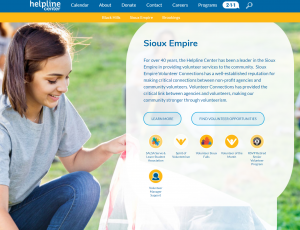There are more than 500 non-profits that have 501c3 status in the Sioux Falls metro. The IRS requires each 501c3 to have a governing board of at least three members to maintain their tax-exempt status. Some non-profit boards exist in name only and others are high-profile, high-effort volunteer roles that require a significant commitment but also allow you to make a real impact. I’ve served on several non-profit boards and committees over the last ten years, from as small as a two-person fundraising effort for a church up to the board of trustees for a seminary that has 400 students. I’ve seen firsthand how non-profit boards operate, what makes them be effective and what doesn’t.
Here are the five tips that will help you be a more successful non-profit board member:
- Make a generational commitment to a cause.
Instead of hopping from board to board as your terms expire, pick a couple of organizations or causes that you can stay committed to over a long period of time. As you gain more experience and institutional knowledge, you will become an expert on your organization’s history and mission and have a better understanding of what your organization should do to move forward. You may not serve on the board consecutively for a decade or more, but you should find ways to stay involved, volunteer and give to that organization.
You will make a much greater impact by going deep with one or two organizations than you will by going wide and spending two or three years at a time with different organizations. To really move the needle on your organization’s mission in your community, it will take many years of consistent learning, leading, giving and doing. When your board only meets once per month and you have a small team of employees to run a non-profit, it just takes time to fully execute on the vision and mission of the organization.
- Attending board meetings isn’t enough.
I am amazed at how many non-profit board members in our community will agree to serve on a board, attend most of the board meetings, but otherwise will have little to no involvement in an organization. Board meetings just help make sure that your organization remains on track. It’s not where the actual meat and potatoes of your organization’s vision and mission occurs. If you are committed to a non-profit, you should give it your time (by volunteering), your talent (by attending board meetings and providing leadership) and your treasure (by giving to the organization). Volunteering and giving will give you a better understanding of the organization that you are helping lead and it will also be personally beneficial to you to see the work you do making an impact in your community.
- Encourage collaboration with other non-profits.

Rich Merkouris, Pastor of King of Glory Church, recently said that the average person in need receives help from four to six different non-profits in our community at the same time. Imagine how much more effective non-profits that work with the poor in our community could be if they worked together to help meet a person’s needs and set them up for success. Merkouris encourages non-profits to ask themselves, “What is something we are doing that someone else is doing better? And, can we partner with them?” As a board member, you should always be looking beyond the silo of your organization and looking for ways to learn from and partner with other non-profit organizations. When possible, collaborate with related non-profits to reduce duplication of services and increase your organization’s overall effectiveness through partnerships.
- Limit yourself to two non-profit boards at a time.
You only have so many hours in a day and you can’t be everything to everybody. Between a full-time job, family responsibilities you may have, and your need to sleep, you can probably effectively serve on at most two non-profit boards at a time if you are truly committed to them.
I’m currently serving on the board of directors for the Zeal Center for Entrepreneurship and the board of trustees for Sioux Falls Seminary, and that’s it. I probably invest between five and eight hours per week of time between these two non-profits. I’ve had to say “no” to other at least four other organizations that asked me to serve on their boards this year, including a couple of organizations that I would have loved to say yes to. I knew if I had said yes, I would be robbing time from the two organizations I am committed to and would be a less effective volunteer and board member overall.
I happen to be a Christian and living out my faith is an important aspect of my life. So, I’ve chosen to serve on one board at a time that has a ministry focus and one board that has more of a community or a business focus. By serving at Sioux Falls Seminary, I’m helping the next generation of pastors, missionaries, therapists and organizational leaders prepare themselves to do Christian ministry work. By serving at the Zeal Center, I have an opportunity to help startup founders and small business owners grow their businesses. Serving on one faith-based board and one non-faith-based board isn’t a hard and fast rule for everyone, but it’s a personal rule that has worked well for me.
- Don’t passively participate in board meetings.
When your organization has its monthly or bi-monthly board meeting, be willing to speak up and share your mind on agenda items. If you attend a board meeting, quietly listen to each agenda item and don’t weigh in on anything, you could simply skip the board meeting and made the same amount of progress. As a board member, it’s your responsibility to contribute to the organization’s ongoing dialogue and help steer it in the right direction. This point might seem rather basic, but you might be surprised how many volunteer board members just don’t speak up at meetings.
- Leverage your relationships for your non-profit.
For a non-profit to be successful, it needs a network of contributors and volunteers that can execute on the organization’s mission. One of your roles as a non-profit board member is to help grow that network. You have a unique set of relationships that others don’t have, and those relationships can be leveraged to help grow and sustain your non-profit. Encourage friends, family members, and business acquaintances to get involved with your non-profit by attending events, volunteering and making donations to your organization.
Wrap-up

Non-profits in the Sioux Falls community do truly amazing work that can literally mean the difference between life or death. From sheltering the homeless, providing therapy to the mentally ill, feeding the hungry, and helping people find jobs and get them to work, there are non-profits that make sure people’s basic needs are met and help them set up for long-term success.
If you aren’t currently involved with a non-profit, I would encourage you to pick one and get involved. It will be good for the community and it will be encouraging to you personally as well. The Helpline Center has a list of volunteer opportunities in Sioux Falls that is a good starting point to identify a non-profit that needs your help.
